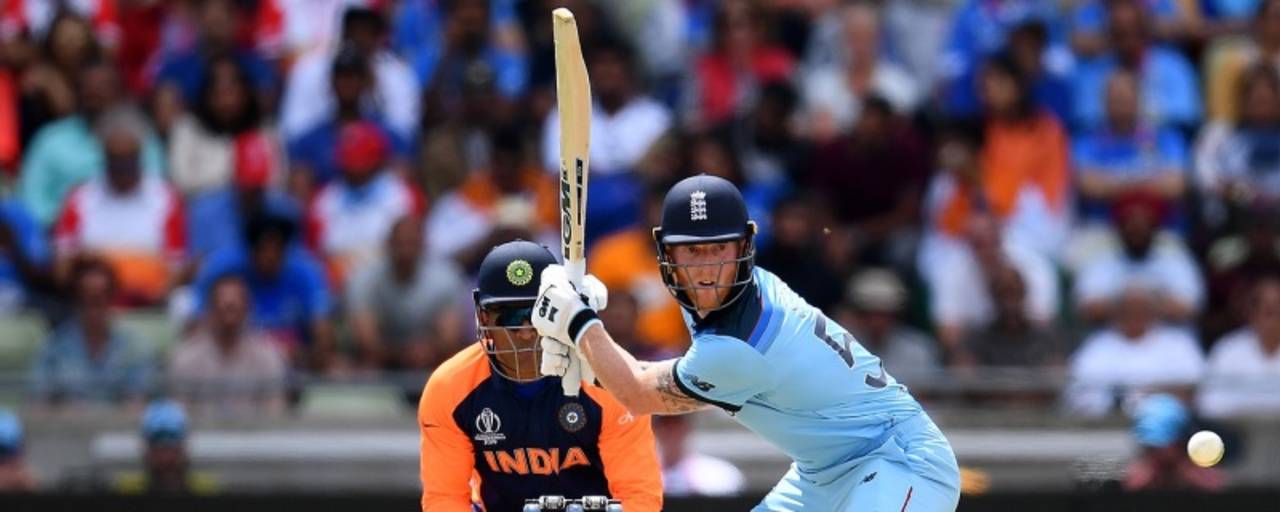Of all the things
Ben Stokes can be told he cannot do, the least acknowledged and most incredible one is that he is as good a middle-order batsman as MS Dhoni once was. No way. No no way.
If he never held an amazing catch again, if he never bowled an over to create something out of nothing ever again, teams should still be prepared to give an arm and a leg for Stokes the No. 5 batsman. Not a hitter, not a bowler, not a gun fielder, but purely as a fine accumulator of runs in the middle overs who can turn it on towards the end. In fact by being an allrounder, Stokes does himself a PR disservice.
In the most difficult batting position for a specialist batsman in ODIs, No. 5, Stokes
has averaged 50.77 and struck at 93.26 since the last World Cup. That's a good 18 and eight points higher than the industry standard. Nos 5 the world over - Stokes included -
have averaged 32.84 and struck at 85.51 per 100 balls over the same period. These numbers get better in chases for Stokes:
60.13 and 95.95. And both his average and strike rate are actually better against spin than against pace.
Add in
Stokes' numbers at other batting positions, and he has averaged 49.04 and struck at 97.75 per 100 balls over this period. There are only two batsmen who are better than him on both the counts: Virat Kohli and David Warner. Stokes belongs to the elite group of eight batsmen who have averaged 47.5 or above and have a strike rate of 95 and above over this period. He, Jos Buttler and AB de Villiers are the ones who bat in the middle or lower-than-middle order.
It has been said, and not without reason, that England are excellent batsmen but only in flat conditions. And that over the last four years they have got those conditions in most places they have played. So there is a call to look at the numbers of England with caution. However, one position where you might want to make more leeway is No. 5.
The No. 5 batsman usually comes into bat when scoring becomes more difficult, but unlike those following him he doesn't have the licence. The No. 5 doesn't have the freedom to eat up dots the way Rohit Sharma, for example, can at the top of the innings and then make up for it later. Every dot accumulates pressure. If he comes in to bat with the freedom to start off slowly, that only happens when the team is three down for not much, which brings a pressure of its own.
Nor can the No. 5 come in and start going bang bang. Buttler has a much greater strike rate, for example, than Stokes. Stokes is basically a Buttler with the added responsibility.
One feeling observers have when Stokes bats is that he starts slow and then makes up with what is perceived as risky shots, which is boundaries. There is merit to it: more than half of his runs from No. 5 over this period have come in boundaries. Other prolific batsmen at that position - Angelo Mathews, Shoaib Malik, MS Dhoni - score only about 40% of their runs in boundaries. Shakib Al Hasan, though, goes at over 50%, but he, too, has moved to No. 3 and blossomed into an even more prolific batsman. That just tells you how limiting No. 5 can be.
Boundaries do involve a bit of risk, but risk is relative. If a man has pulled it off for four years he must not be taking that much of a risk keeping his batting and striking ability in mind. His strike rate over the first 20 balls over these four years has been 82.75. His average innings is 40 balls long. So if he ending up with an overall strike rate of 97.75, on an average he has been causing serious carnage once he gets in.
Stokes has clearly got a method, which seems to be working for him. He has got a solid defence, he can absorb pressure, he can rotate the strike once he gets into an innings, and he can hit boundaries without taking too many risks. He is an insurance against a collapse, but also there to capitalise when the start has been good. He is actually the one batsman who tempers his game according to the conditions and situations.
If anything, since the Bristol incident Stokes has become a more responsible batsman. He is quick to argue that it wasn't as though he ever left the pitch thinking he could have given a bit more of himself. It is just that he has eschewed a few of the risks.
"The difference is that his batting has become careful now whereas before it was carefree," team-mate Moeen Ali told ESPNcricinfo. "He is slowly getting back to that way, but it will take time.
"I think he feels like he's let us down a little bit and he's trying to make it up. He doesn't. He doesn't owe me anything. I feel he was defending other people. But you can understand it. I think he feels like he owes the team and he feels like he needs to give back which has taken a bit of time."
At this World Cup, Stokes has been back to his best: averaging 61.66 and striking at 98.93 on tracks that have shown up a few of his team-mates. There are no hundreds in there, which might suggest he has run out of time and perhaps could be better utilised at No. 4. Which might well be the case, but does somebody else have the skills to be that good at No. 5? No way. No no way.
Sidharth Monga is an assistant editor at ESPNcricinfo




